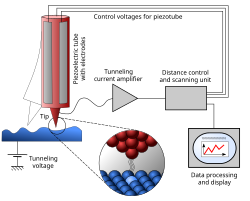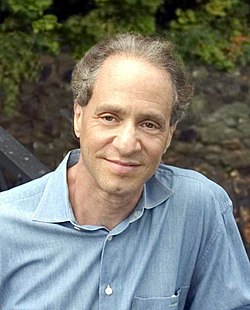هˆ†هگمƒٹمƒژمƒ†م‚¯مƒژمƒم‚¸مƒ¼مپ«é–¢مپ™م‚‹مƒ‰مƒ¬م‚¯م‚¹مƒ©مƒ¼مپ¨م‚¹مƒ¢مƒ¼مƒھمƒ¼مپ®è«–ن؛‰هˆ†هگمƒٹمƒژمƒ†م‚¯مƒژمƒم‚¸مƒ¼مپ«é–¢مپ™م‚‹مƒ‰مƒ¬م‚¯م‚¹مƒ©مƒ¼مپ¨م‚¹مƒ¢مƒ¼مƒھمƒ¼مپ®è«–ن؛‰ï¼ˆمپ¶م‚“مپ—مƒٹمƒژمƒ†م‚¯مƒژمƒم‚¸مƒ¼مپ«مپ‹م‚“مپ™م‚‹مƒ‰مƒ¬م‚¯م‚¹مƒ©مƒ¼مپ¨م‚¹مƒ¢مƒ¼مƒھمƒ¼مپ®م‚چم‚“مپمپ†ï¼‰مپ§مپ¯م€پهˆ†هگمƒٹمƒژمƒ†م‚¯مƒژمƒم‚¸مƒ¼مپ®و¦‚ه؟µçڑ„مپھهں؛ç¤ژم‚’و‰“مپ،ç«‹مپ¦مپںKمƒ»م‚¨مƒھمƒƒم‚¯مƒ»مƒ‰مƒ¬م‚¯م‚¹مƒ©مƒ¼مپ¨م€پمƒٹمƒژ物è³ھC60مƒ•مƒ©مƒ¼مƒ¬مƒ³م‚’ç™؛見مپ—مپںمپ“مپ¨مپ§1996ه¹´مپ® مƒژمƒ¼مƒ™مƒ«هŒ–ه¦è³م‚’هڈ—è³مپ—مپںمƒھمƒپمƒ£مƒ¼مƒ‰مƒ»م‚¹مƒ¢مƒ¼مƒھمƒ¼مپ¨مپ®é–“مپ§è،Œم‚ڈم‚Œمپںم€پهˆ†هگمƒٹمƒژمƒ†م‚¯مƒژمƒم‚¸مƒ¼مپ«é–¢مپ™م‚‹ه…¬é–‹è«–ن؛‰مپ«مپ¤مپ„مپ¦è؟°مپ¹م‚‹م€‚مپمپ®ن؛‰ç‚¹مپ¯م€په€‹م€…مپ®هژںهگم‚„هˆ†هگم‚’و“چن½œمپ™م‚‹مپ“مپ¨مپ«م‚ˆمپ£مپ¦هˆ†هگوگو–™م‚„هˆ†هگمƒ‡مƒگم‚¤م‚¹م‚’è‡ھه¾‹çڑ„مپ«و§‹ç¯‰مپ™م‚‹هˆ†هگمƒم‚·مƒ³م€پمپ™مپھم‚ڈمپ،هˆ†هگم‚¢م‚»مƒ³مƒ–مƒ©مپŒه®ںçڈ¾هڈ¯èƒ½مپ‹مپ¨مپ„مپ†مپ“مپ¨مپ§مپ‚مپ£مپںم€‚هˆ†هگم‚¢م‚»مƒ³مƒ–مƒ©مپ¯مƒ‰مƒ¬م‚¯م‚¹مƒ©مƒ¼مپ®ه‰µو،ˆمپ«م‚ˆم‚‹هˆ†هگمƒٹمƒژمƒ†م‚¯مƒژمƒم‚¸مƒ¼مپ®ن¸و ¸و¦‚ه؟µمپ§مپ‚مپ£مپںمپŒم€پم‚¹مƒ¢مƒ¼مƒھمƒ¼مپ¯مپمپ®هکهœ¨مپŒç‰©çگ†ه¦مپ®هں؛وœ¬هژںçگ†مپ«هڈچمپ—مپ¦مپ„م‚‹مپ¨ن¸»ه¼µمپ—مپںم€‚مپ¾مپںن¸،者مپ¯ن؛’مپ„مپ«م€پمƒٹمƒژمƒ†م‚¯مƒژمƒم‚¸مƒ¼مپ«ه¯¾مپ™م‚‹ç›¸و‰‹مپ®è€ƒمپˆو–¹مپŒن¸€èˆ¬مپ®م‚¤مƒ،مƒ¼م‚¸م‚’و‚ھهŒ–مپ•مپ›مپ¦مپٹم‚ٹم€پمƒٹمƒژمƒ†م‚¯ç ”究مپ¸مپ®و”¯وڈ´م‚’途絶مپˆمپ•مپ›مپ‹مپمپھمپ„مپ¨é難مپ—هگˆمپ£مپںم€‚ è«–ن؛‰مپ¯2001ه¹´مپ‹م‚‰2003ه¹´مپ«مپ‹مپ‘مپ¦é›‘èھŒمپ¸مپ®ه¯„ç¨؟مپ¨ه…¬é–‹و›¸ç°،مپ«م‚ˆمپ£مپ¦è،Œم‚ڈم‚Œمپںم€‚هڈ£çپ«م‚’هˆ‡مپ£مپںمپ®مپ¯م‚¹مƒ¢مƒ¼مƒھمƒ¼مپŒ2001ه¹´مپ«م€ژم‚µم‚¤م‚¨مƒ³مƒ†م‚£مƒ•م‚£مƒƒم‚¯مƒ»م‚¢مƒ،مƒھم‚«مƒ³م€ڈèھŒمپ«و›¸مپ„مپں論考مپ§مپ‚م‚‹م€‚هگŒه¹´مپ«مƒ‰مƒ¬م‚¯م‚¹مƒ©مƒ¼مپ¯ه…±هگŒç ”究者مپ¨مپ¨م‚‚مپ«هڈچè«–و–‡م‚’ç™؛è،¨مپ—م€پمپ•م‚‰مپ«2003ه¹´هˆé مپ«2é€ڑمپ®ه…¬é–‹çٹ¶م‚’و›¸مپ„مپںم€‚هگŒه¹´وœ«مپ« Chemical & Engineering News èھŒمپ§ç‰¹é›†è¨کن؛‹مپŒçµ„مپ¾م‚Œم€پن¸،者مپ«م‚ˆم‚‹èھŒن¸ٹè¨ژè«–مپŒè،Œم‚ڈم‚Œمپںمپ“مپ¨مپ§è«–ن؛‰مپ¯çµ‚çµگمپ—مپںم€‚ è°è«–م‚’وˆ¦م‚ڈمپ›مپںن؛Œن؛؛مپ®هگچه£°مپŒé«کمپ„مپ“مپ¨مپ¨م€پمƒٹمƒژمƒ†م‚¯مƒژمƒم‚¸مƒ¼مپ®وٹ€è،“çڑ„هپ´é¢مپ¨ç¤¾ن¼ڑçڑ„هپ´é¢مپ®ن¸،و–¹مپ«è«–مپŒهڈٹم‚“مپ مپ“مپ¨مپ‹م‚‰م€پمپ“مپ®è«–ن؛‰مپ¯مƒٹمƒژمƒ†م‚¯مƒژمƒم‚¸مƒ¼مپ®و´هڈ²مپ®ن¸مپ§م‚ˆمپڈهڈ–م‚ٹن¸ٹمپ’م‚‰م‚Œمپ¦مپچمپںم€‚هٹ مپˆمپ¦م€پهڈŒو–¹مپ®è«–èھ؟مپŒو•µه¯¾çڑ„مپھ色هگˆمپ„م‚’ه¸¯مپ³مپ¦مپ„مپںمپ“مپ¨مپ«مپ¯ه¤ڑمپڈمپ®و‰¹هˆ¤مپŒه¯„مپ›م‚‰م‚Œمپ¦مپچمپںم€‚مƒ‰مƒ¬م‚¯م‚¹مƒ©مƒ¼مپ¯م‚¹مƒ¢مƒ¼مƒھمƒ¼مپŒè‡ھè؛«مپ®ç ”究م‚’وھو›²مپ—مپںمپ¨é難مپ—م€پم‚¹مƒ¢مƒ¼مƒھمƒ¼مپ¯مƒ‰مƒ¬م‚¯م‚¹مƒ©مƒ¼مپŒç§‘ه¦مپ®هں؛ç¤ژم‚’çگ†è§£مپ—مپ¦مپ„مپھمپ„مپ¨ه؟œé…¬مپ—مپںم€‚èک者مپ¯مپ“مپ®è«–ن؛‰م‚’م€Œمپٹمپ—مپ£مپ“飛مپ°مپ—競ن؛‰م€چ[1](و—¥وœ¬èھمپ§è¨€مپ†م€Œو³¥ن»•هگˆم€چ)مپ«ن¾‹مپˆمپںم‚ٹم€پم€Œم€ژم‚µم‚؟مƒ‡مƒ¼مƒ»مƒٹم‚¤مƒˆمƒ»مƒ©م‚¤مƒ–م€ڈ مپ®م‚³مƒ³مƒˆم‚’ه½·ه½؟مپ¨مپ•مپ›م‚‹م€چ[2]مپ¨è©•مپ™م‚‹مپ“مپ¨مپ•مپˆمپ‚مپ£مپںم€‚ 論者Kمƒ»م‚¨مƒھمƒƒم‚¯مƒ»مƒ‰مƒ¬م‚¯م‚¹مƒ©مƒ¼ →詳細مپ¯م€ŒKمƒ»م‚¨مƒھمƒƒم‚¯مƒ»مƒ‰مƒ¬م‚¯م‚¹مƒ©مƒ¼م€چم‚’هڈ‚ç…§
Kمƒ»م‚¨مƒھمƒƒم‚¯مƒ»مƒ‰مƒ¬م‚¯م‚¹مƒ©مƒ¼مپ¯مƒٹمƒژمƒ†م‚¯مƒژمƒم‚¸مƒ¼مپ«é–¢مپ™م‚‹ه¦è،“çڑ„مپھè«–و–‡م‚’هˆم‚پمپ¦و›¸مپ„مپںن؛؛物مپ مپ¨مپ•م‚Œمپ¦مپ„م‚‹[3][4]م€‚è‘—è؟°م‚’é€ڑمپ—مپ¦م€پمپ¾مپںم‚¹مƒمƒ¼م‚¯م‚¹مƒمƒ³مپ¨مپ—مپ¦م€پمƒٹمƒژمƒ†م‚¯مƒژمƒم‚¸مƒ¼مپ®و¦‚ه؟µم‚’ن¸€èˆ¬مپ«وµ¸é€ڈمپ•مپ›مپںن¸ه؟ƒçڑ„ن؛؛物مپ§م‚‚مپ‚مپ£مپں[3][5]م€‚ه·¥ه¦è€…مپ§مپ‚مپ£مپںمƒ‰مƒ¬م‚¯م‚¹مƒ©مƒ¼مپ¯م€پ物çگ†ه¦è€…مƒھمƒپمƒ£مƒ¼مƒ‰مƒ»مƒ•م‚،م‚¤مƒ³مƒمƒ³مپŒ1959ه¹´مپ«è،Œمپ£مپں講و¼”م€ژم‚¼م‚¢مƒ¼م‚؛مƒ»مƒ—مƒ¬مƒ³مƒ†م‚£مƒ»م‚ھمƒ–مƒ»مƒ«مƒ¼مƒ مƒ»م‚¢مƒƒمƒˆمƒ»م‚¶مƒ»مƒœمƒˆمƒ م€ڈمپ‹م‚‰ه¤§مپچمپھه½±éں؟م‚’هڈ—مپ‘مپںم€‚مپ“مپ®è¬›و¼”مپ¯ه½“و™‚و³¨ç›®مپ•م‚Œمپ¦مپ„مپھمپ‹مپ£مپںمپŒم€پمƒˆمƒƒمƒ—مƒ€م‚¦مƒ³مپ®ه·¥ه¦çڑ„مپھو–¹و³•مپ«م‚ˆمپ£مپ¦ه€‹م€…مپ®هژںهگم‚’و“چن½œمپ™م‚‹مپ“مپ¨مپŒç‰©çگ†çڑ„مپ«هڈ¯èƒ½مپ§مپ¯مپھمپ„مپ‹مپ¨وڈگو،ˆمپ™م‚‹م‚‚مپ®مپ مپ£مپںم€‚مپ¾مپںمƒ‰مƒ¬م‚¯م‚¹مƒ©مƒ¼مپ¯éپ؛ن¼هگ組وڈ›مپˆوٹ€è،“مپ®م‚ˆمپ†مپھه…ˆç«¯çڑ„مپھهˆ†هگç”ں物ه¦مپ‹م‚‰م‚‚ه½±éں؟م‚’هڈ—مپ‘مپ¦مپ„مپںم€‚1981ه¹´م€پمƒ‰مƒ¬م‚¯م‚¹مƒ©مƒ¼مپ¯ Proceedings of the National Academy of Sciences èھŒمپ«مƒٹمƒژمƒ†م‚¯مƒژمƒم‚¸مƒ¼مپ«é–¢مپ™م‚‹وœ€هˆمپ®é›‘èھŒè«–و–‡مپ¨مپ•م‚Œم‚‹è«–考م‚’وٹ•ç¨؟مپ—م€پمƒھمƒœم‚½مƒ¼مƒ مپھمپ©مپ®ç”ںن½“系物è³ھمپŒهژںهگم‚’ن¸€مپ¤ن¸€مپ¤ç©چمپ؟ن¸ٹمپ’مپ¦هˆ†هگم‚’و§‹ç¯‰مپ—مپ¦مپ„م‚‹مپ“مپ¨م‚’وŒ‡و‘کمپ™م‚‹مپ¨مپ¨م‚‚مپ«م€پن؛؛ه·¥çڑ„مپھو©ںو¢°مپ«م‚‚مپمپ®م‚ˆمپ†مپھ能هٹ›م‚’وŒپمپںمپ›م‚‹مپ“مپ¨مپŒهڈ¯èƒ½مپ مپ¨ن¸»ه¼µمپ—مپں[6]م€‚ه¾Œمپ«مƒ‰مƒ¬م‚¯م‚¹مƒ©مƒ¼مپ¯مƒٹمƒژمƒ†م‚¯مƒژمƒم‚¸مƒ¼م‚’é،Œوگمپ¨مپ—مپںوœ¬م‚’ن؛Œه†ٹو›¸مپ„مپںم€‚ن¸€èˆ¬هگ‘مپ‘مپ®م€ژه‰µé€ مپ™م‚‹و©ںو¢°م€ڈ[7]م€په°‚é–€ه®¶هگ‘مپ‘مپ®م€ژمƒٹمƒژم‚·م‚¹مƒ†مƒ م‚؛م€ڈ[8]مپ§مپ‚م‚‹م€‚مپ¾مپںهˆ†هگمƒٹمƒژمƒ†م‚¯مƒژمƒم‚¸مƒ¼مپ®èھچçں¥مپ¨çگ†è§£م‚’هگ‘ن¸ٹمپ•مپ›م‚‹مپ“مپ¨م‚’ç›®çڑ„مپ¨مپ—مپںه…¬ç›ٹه›£ن½“ Foresight Institute مپ®ه…±هگŒè¨ç«‹è€…مپ¨مپھمپ£مپں[3]م€‚ مƒ‰مƒ¬م‚¯م‚¹مƒ©مƒ¼مپŒو€مپ„وڈڈمپ„مپںمƒٹمƒژمƒ†م‚¯مƒژمƒم‚¸مƒ¼مپ¯çڈ¾هœ¨مپ§مپ¯هˆ†هگمƒٹمƒژمƒ†م‚¯مƒژمƒم‚¸مƒ¼مپ¨ه‘¼مپ°م‚Œمپ¦مپ„م‚‹م€‚مپمپ®هں؛وœ¬مپ¨مپھم‚‹م‚¢م‚¤مƒ‡م‚£م‚¢مپŒم€پهژںهگن¸€ه€‹ن¸€ه€‹م‚’組مپ؟ç«‹مپ¦مپ¦هˆ†هگم€پ特مپ«هˆ†هگمƒ‡مƒگم‚¤م‚¹م‚’ن½œè£½مپ™م‚‹هˆ†هگمƒم‚·مƒ³م€پمپ™مپھم‚ڈمپ،هˆ†هگم‚¢م‚»مƒ³مƒ–مƒ©مپ§مپ‚مپ£مپںم€‚مƒ‰مƒ¬م‚¯م‚¹مƒ©مƒ¼مپ¯ç”ںن½“ç³»م‚’هں؛盤مپ¨مپ™م‚‹م‚¦م‚§مƒƒمƒˆمƒ»مƒٹمƒژمƒ†م‚¯مƒژمƒم‚¸مƒ¼مپ¨م€پو©ںو¢°ه·¥ه¦مپ«è؟‘مپ„و–¹ه¼ڈمپ§هˆ†هگمپ®ن½چç½®هˆ¶ه¾،م‚’è،Œمپ†مƒ،م‚«مƒژهگˆوˆگمپ«م‚ˆم‚‹م€Œç¬¬ن؛Œن¸–ن»£م€چمپ®مƒ‰مƒ©م‚¤مƒ»مƒٹمƒژمƒ†م‚¯مƒژمƒم‚¸مƒ¼مپ¨م‚’وکژç¢؛مپ«هŒ؛هˆ¥مپ—مپںم€‚مƒ‰مƒ¬م‚¯م‚¹مƒ©مƒ¼مپ¨ه½¼مپ«ه…±é³´مپ™م‚‹ç ”究者مپںمپ،مپ¯م‚‚مپ£مپ±م‚‰ه¾Œè€…مپ®و–¹ه¼ڈمپ«هٹ›م‚’و³¨مپ„مپ مپŒم€پمƒ‰مƒ¬م‚¯م‚¹مƒ©مƒ¼مپ¯هˆ†هگمƒم‚·مƒ³م‚·م‚¹مƒ†مƒ م‚’ن½œم‚ٹه‡؛مپ™éپ“ç‹مپ¨مپ—مپ¦مپ©مپ،م‚‰م‚‚ه¦¥ه½“مپھم‚‚مپ®مپ مپ¨è؟°مپ¹مپ¦مپ„م‚‹[3]م€‚ مƒھمƒپمƒ£مƒ¼مƒ‰مƒ»م‚¹مƒ¢مƒ¼مƒھمƒ¼â†’詳細مپ¯م€Œمƒھمƒپمƒ£مƒ¼مƒ‰مƒ»م‚¹مƒ¢مƒ¼مƒھمƒ¼م€چم‚’هڈ‚ç…§
مƒ©م‚¤م‚¹ه¤§ه¦مپ«هœ¨ç±چمپ—مپ¦مپ„مپںهŒ–ه¦è€…مƒھمƒپمƒ£مƒ¼مƒ‰مƒ»م‚¹مƒ¢مƒ¼مƒھمƒ¼مپ¯م€پ1985ه¹´مپ«مƒڈمƒمƒ«مƒ‰مƒ»م‚¯مƒمƒˆمƒ¼م€پمƒمƒگمƒ¼مƒˆمƒ»م‚«مƒ¼مƒ«م€پم‚¸م‚§مƒ¼مƒ م‚؛مƒ»مƒ’مƒ¼م‚¹م€پم‚·مƒ§مƒ¼مƒ³مƒ»م‚ھمƒ–مƒ©م‚¤م‚¨مƒ³م‚‰مپ¨مپ¨م‚‚مپ«C60مƒ•مƒ©مƒ¼مƒ¬مƒ³ï¼ˆمƒگمƒƒم‚¯مƒںمƒ³م‚¹م‚؟مƒ¼مƒ•مƒ©مƒ¼مƒ¬مƒ³ï¼‰مپ¨ه‘¼مپ°م‚Œم‚‹ç‚ç´ هگŒç´ ن½“م‚’ç™؛見مپ—مپںمپ“مپ¨مپ§م‚‚مپ£مپ¨م‚‚م‚ˆمپڈçں¥م‚‰م‚Œمپ¦مپ„م‚‹م€‚م‚«مƒ¼مƒœمƒ³مƒٹمƒژمƒپمƒ¥مƒ¼مƒ–مپھمپ©م‚’هگ«م‚€هگŒç¨®مپ®ç‰©è³ھمپ¯مƒ•مƒ©مƒ¼مƒ¬مƒ³مپ¨ç·ڈ称مپ•م‚Œم‚‹م‚ˆمپ†مپ«مپھمپ£مپںم€‚مƒ•مƒ©مƒ¼مƒ¬مƒ³مپ®ç ”究مپ¨ه؟œç”¨مپ¯مƒٹمƒژمƒمƒ†مƒھم‚¢مƒ«مپ¨مƒٹمƒژم‚¨مƒ¬م‚¯مƒˆمƒمƒ‹م‚¯م‚¹مپ®هˆ†é‡ژمپ§é‡چè¦پمپھن½چç½®م‚’هچ م‚پم‚‹م‚ˆمپ†مپ«مپھم‚ٹم€پمپمپ®ç™؛見مپ«م‚ˆم‚ٹم‚¹مƒ¢مƒ¼مƒھمƒ¼م€پم‚¯مƒمƒˆمƒ¼مپٹم‚ˆمپ³م‚«مƒ¼مƒ«مپ¯1996ه¹´مپ®مƒژمƒ¼مƒ™مƒ«هŒ–ه¦è³م‚’هڈ—è³مپ—مپں[9]م€‚ م‚¹مƒ¢مƒ¼مƒھمƒ¼مپ¯مƒٹمƒژمƒ†م‚¯مƒژمƒم‚¸مƒ¼مپ«é–¢مپ™م‚‹ه…¬ه…±و”؟ç–و±؛ه®ڑمپ§م‚‚éڑ›ç«‹مپ£مپںه½¹ه‰²م‚’وœمپںمپ—مپ¦مپٹم‚ٹم€پن¸–ç•Œçڑ„مپھم‚¨مƒچمƒ«م‚®مƒ¼ه•ڈé،Œم‚„ن؟هپ¥ه•ڈé،Œم‚’解و±؛مپ™م‚‹مپںم‚پمپ«مƒٹمƒژمƒ†م‚¯مƒژمƒم‚¸مƒ¼م‚’ه؟œç”¨مپ™م‚‹مپ“مپ¨م‚’ç²¾هٹ›çڑ„مپ«ه”±éپ“مپ—مپںم€‚مپمپ“مپ§وڈگèµ·مپ•م‚Œمپںمپ®مپ¯م€پمپںمپ¨مپˆمپ°مƒٹمƒژوگو–™م‚’用مپ„مپںهٹ¹çژ‡çڑ„مپھم‚¨مƒچمƒ«م‚®مƒ¼è²¯è”µمپ¨ن¼éپ”م‚„م€پو¨™çڑ„هŒ–مƒ‰مƒ©مƒƒم‚°مƒ‡مƒھمƒگمƒھمƒ¼مپ®مپںم‚پمپ®مƒٹمƒژمƒ،مƒ‡م‚£م‚·مƒ³مپ®هڈ¯èƒ½و€§مپ§مپ‚م‚‹م€‚م‚¹مƒ¢مƒ¼مƒھمƒ¼مپ¯م‚«مƒ¼مƒœمƒ³مƒٹمƒژمƒپمƒ¥مƒ¼مƒ–مپ«مپ¤مپ„مپ¦مپ®ه¦è،“ç ”ç©¶م‚’ه•†و¥هŒ–مپ™م‚‹مپ“مپ¨مپ«م‚‚ç©چو¥µçڑ„مپ§م€پم‚«مƒ¼مƒœمƒ³مƒ»مƒٹمƒژمƒ†م‚¯مƒژمƒم‚¸مƒ¼م‚؛社م‚’ه‰µè¨مپ—مپںمپ»مپ‹م€پمƒگم‚¤م‚ھمƒ†م‚¯مƒژمƒم‚¸مƒ¼مپ¨مƒٹمƒژمƒ†م‚¯مƒژمƒم‚¸مƒ¼مپ«é–¢é€£مپ™م‚‹م‚¹م‚؟مƒ¼مƒˆم‚¢مƒƒمƒ—ن¼پو¥2社مپ§ç§‘ه¦é،§ه•ڈه§”ه“،م‚’ه‹™م‚پمپںم€‚م‚¹مƒ¢مƒ¼مƒھمƒ¼مپ¯مƒ‰مƒ¬م‚¯م‚¹مƒ©مƒ¼مپ¨مپ®è«–ن؛‰مپŒو±؛ç€م‚’見مپںه¾Œمپ«م€پ2005ه¹´10وœˆمپ«ç™½è،€ç—…مپ§و»ن؛،مپ—مپں[10][11]م€‚ è«–ن؛‰م€ژم‚µم‚¤م‚¨مƒ³مƒ†م‚£مƒ•م‚£مƒƒم‚¯مƒ»م‚¢مƒ،مƒھم‚«مƒ³م€ڈèھŒمپ¸مپ®م‚¹مƒ¢مƒ¼مƒھمƒ¼مپ®ه¯„ç¨؟م‚¹مƒ¢مƒ¼مƒھمƒ¼مپ¯2001ه¹´9وœˆمپ«ç™؛è،Œمپ•م‚Œمپںن¸€èˆ¬هگ‘مپ‘科ه¦é›‘èھŒم€ژم‚µم‚¤م‚¨مƒ³مƒ†م‚£مƒ•م‚£مƒƒم‚¯مƒ»م‚¢مƒ،مƒھم‚«مƒ³م€ڈمپ®مƒٹمƒژمƒ†م‚¯مƒژمƒم‚¸مƒ¼ç‰¹é›†هڈ·مپ«م€ŒهŒ–ه¦م€پو„›م€پمƒٹمƒژمƒمƒœمƒƒمƒˆمپ®مپ“مپ¨م€چمپ¨é،Œمپ™م‚‹è«–考م‚’و›¸مپ„مپں[12]م€‚مپمپ®ه†’é مپ§م‚¹مƒ¢مƒ¼مƒھمƒ¼مپ¯هŒ–ه¦هڈچه؟œم‚’هژںهگمپ«م‚ˆم‚‹è¤‡é›‘مپھمƒ€مƒ³م‚¹مپ«ن¾‹مپˆمپںم€‚
م‚¹مƒ¢مƒ¼مƒھمƒ¼مپ¯هˆ†هگم‚¢م‚»مƒ³مƒ–مƒ©م€پمپ™مپھم‚ڈمپ،ه€‹م€…مپ®هژںهگم‚’و“چن½œمپ—مپ¦وœ›مپ؟مپ®ç‰©è³ھم‚’و§‹ç¯‰مپ™م‚‹مپ“مپ¨مپŒمپ§مپچم‚‹مƒٹمƒژمƒمƒœمƒƒمƒˆمپ®و¦‚ه؟µم‚’話é،Œمپ«وŒ™مپ’م€پم‚¢م‚»مƒ³مƒ–مƒ©مپŒو„ڈه‘³مپ®مپ‚م‚‹é‡ڈمپ®ç‰©è³ھم‚’ç”ں産مپ™م‚‹مپ®مپ«مپ©م‚Œمپ»مپ©و™‚é–“مپŒمپ‹مپ‹م‚‹مپ‹مپ¨ه•ڈمپ„مپ‹مپ‘مپںم€‚ه½¼مپ®è©¦ç®—مپ§مپ¯م€پهچک独مپ§و´»ه‹•مپ™م‚‹م‚¢م‚»مƒ³مƒ–مƒ©مپŒ1مƒ¢مƒ«مپ®ç‰©è³ھم‚’ç”ں産مپ™م‚‹مپ«مپ¯و•°ç™¾ن¸‡ه¹´مپ®و™‚é–“مپŒمپ‹مپ‹م‚‹مپŒم€پè‡ھه·±è¤‡è£½ه‹مپ®م‚¢م‚»مƒ³مƒ–مƒ©مپŒ1هˆ†é–“مپ«م‚ڈمپںمپ£مپ¦ه¢—و®–م‚’ç¹°م‚ٹè؟”مپ—مپںمپھم‚‰مپ°م€پم‚¢م‚»مƒ³مƒ–مƒ©é›†ه›£مپ¯1مƒںمƒھ秒م‚‚مپ‹مپ‹م‚‰مپڑمپ«1مƒ¢مƒ«مپ®ç‰©è³ھم‚’ç”ں産مپ§مپچم‚‹مپ¨مپ•م‚Œمپںم€‚م‚¹مƒ¢مƒ¼مƒھمƒ¼مپ¯مپ“مپ“مپ‹م‚‰è«–م‚’進م‚پمپ¦م€پè‡ھه·±è¤‡è£½ه‹مƒٹمƒژمƒمƒœمƒƒمƒˆمپŒçھپ然ه¤‰ç•°م‚’èµ·مپ“مپ—مپ¦éڑ›é™گمپھمپڈè‡ھه·±ç”ں産م‚’è،Œمپ„م€پمپ„م‚ڈم‚†م‚‹م‚°مƒ¬م‚¤م‚°مƒ¼مپŒç™؛ç”ںمپ™م‚‹مپ¨مپ„مپ†م‚·مƒٹمƒھم‚ھم‚„م€پمƒ“مƒ«مƒ»م‚¸مƒ§م‚¤مپ®م‚¨مƒƒم‚»م‚¤م€Œمپھمپœوœھو¥مپ¯م‚ڈم‚Œم‚ڈم‚Œم‚’ه؟…è¦پمپ¨مپ—مپھمپ„مپ®مپ‹ï¼ںم€چ[13]مپ®ه¼•ç”¨مپ¨مپ—مپ¦م€پمƒٹمƒژمƒمƒœمƒƒمƒˆمپŒç¾¤çں¥èƒ½م‚’ç™؛éپ”مپ•مپ›مپ¦مپ‚م‚‹ç¨®مپ®ç”ںه‘½ن½“مپ¨مپھم‚‹هچ±é™؛و€§م‚’è«–مپکمپںم€‚ و¬،مپ«م€پè‡ھه·±è¤‡è£½ه‹مƒٹمƒژمƒمƒœمƒƒمƒˆمپ¨مپ„مپ†م‚¢م‚¤مƒ‡م‚£م‚¢مپ«مپ©م‚Œمپ»مپ©çڈ¾ه®ںو€§مپŒمپ‚م‚‹مپ‹è€ƒه¯ںمپ•م‚Œمپںم€‚م‚¹مƒ¢مƒ¼مƒھمƒ¼مپ®è¨€مپ«م‚ˆم‚Œمپ°م€پهŒ–ه¦هڈچه؟œمپ®ن¸مپ§مپ¯مپ™مپ¹مپ¦مپ®هŒ–ه¦çµگهگˆمپŒç›¸ن؛’مپ«çµ،مپ؟هگˆمپ£مپ¦مپٹم‚ٹم€پن¸€مپ¤مپ®هژںهگمپ®é…چç½®مپ¯ن»کè؟‘مپ«مپ‚م‚‹مپ™مپ¹مپ¦مپ®هژںهگمپ®ن½چç½®مپ‹م‚‰ه¤ڑه¤§مپھه½±éں؟م‚’هڈ—مپ‘م‚‹م€‚مپ—مپںمپŒمپ£مپ¦هˆ†هگم‚¢م‚»مƒ³مƒ–مƒ©مپŒو©ں能مپ™م‚‹مپ«مپ¯ه¤ڑمپڈمپ®هژںهگم‚’هگŒو™‚مپ«هˆ¶ه¾،مپ—مپھمپ‘م‚Œمپ°مپھم‚‰مپڑم€پمپمپ®مپںم‚پمپ«ه¤ڑو•°مپ®مƒمƒ‹مƒ”مƒ¥مƒ¬مƒ¼م‚؟هژںهگم‚’ه‚™مپˆمپ¦مپ„مپھمپ‘م‚Œمپ°مپھم‚‰مپھمپ„م€‚مپ“مپ“مپ§م‚¹مƒ¢مƒ¼مƒھمƒ¼مپ¯هˆ†هگم‚¢م‚»مƒ³مƒ–مƒ©مپ®و¦‚ه؟µمپ«ن؛Œمپ¤مپ®é›£ç‚¹مپŒمپ‚م‚‹مپ¨ن¸»ه¼µمپ—م€پمپم‚Œمپم‚Œم€Œه¤ھمپ„وŒ‡مپ®ه•ڈé،Œم€چمپ¨م€Œمپ¹مپںمپ¤مپڈوŒ‡مپ®ه•ڈé،Œم€چمپ¨ه‘¼م‚“مپ م€‚
م‚¹مƒ¢مƒ¼مƒھمƒ¼مپ¯وœ€ه¾Œمپ«ه†چمپ³و„›مپ®مƒ€مƒ³م‚¹مپ®م‚¢مƒٹمƒم‚¸مƒ¼م‚’وŒپمپ،ه‡؛مپ—م€پم€Œه¥³مپ®هگمپ¨ç”·مپ®هگم‚’ن؛’مپ„مپ«هگ‘مپ‘مپ¦هœ§è؟«مپ—مپںمپ¨مپ“م‚چمپ§وپ‹مپ¯èٹ½ç”ںمپˆمپھمپ„م€چمپ¨è؟°مپ¹مپںم€‚ مƒ‰مƒ¬م‚¯م‚¹مƒ©مƒ¼مپ®هڈچ論(ن¸ٹ)مƒھمƒœم‚½مƒ¼مƒ مپ®و¨،ه¼ڈه›³م€‚ه°ڈمپ•مپھم‚¢مƒںمƒژé…¸مپ‹م‚‰م‚؟مƒ³مƒ‘م‚¯è³ھمپ®é«کهˆ†هگم‚’و£ç¢؛مپ«و§‹ç¯‰مپ™م‚‹مƒھمƒœم‚½مƒ¼مƒ مپ¯م€پمƒ‰مƒ¬م‚¯م‚¹مƒ©مƒ¼مپ«م‚ˆمپ£مپ¦ç”ںن½“çڑ„مپھهˆ†هگمƒم‚·مƒ³مپ®ن¾‹مپ¨مپ•م‚Œمپںم€‚م‚¢مƒ‹مƒ،مƒ¼م‚·مƒ§مƒ³مپ‚م‚ٹم€‚(ن¸‹ï¼‰èµ°وں»ه‹مƒˆمƒ³مƒچمƒ«é،•ه¾®éڈ،مپ®و¨،ه¼ڈه›³م€‚مƒ‰مƒ¬م‚¯م‚¹مƒ©مƒ¼مپ¯ه€‹م€…مپ®هˆ†هگمپ®ن½چç½®هˆ¶ه¾،مپŒهڈ¯èƒ½مپ§مپ‚م‚‹ه®ںن¾‹مپ¨مپ—مپ¦مپ“مپ®è£…ç½®م‚’وŒ™مپ’مپںم€‚ مƒ‰مƒ¬م‚¯م‚¹مƒ©مƒ¼مپ¯مپ“م‚Œمپ«ç”مپˆمپ¦م€پهگŒه¹´وœ«مپ«هˆ†هگمƒمƒ‹مƒ¥مƒ•م‚،م‚¯مƒپمƒ£مƒھمƒ³م‚°ç ”究و‰€مپ‹م‚‰م€Œç‰©çگ†ه¦م€پç¤ژم€پمƒٹمƒژمƒمƒœمƒƒمƒˆمپ«مپ¤مپ„مپ¦م€چمپ¨é،Œمپ—مپںهڈچè«–مپ®و›¸ç°،م‚’ه…¬é–‹مپ—مپںم€‚ه…±è‘—者مپ¨مپ—مپ¦مƒمƒگمƒ¼مƒˆمƒ»مƒ•مƒ¬م‚¤م‚؟م‚¹م€پJمƒ»م‚¹مƒˆمƒ¼م‚؛مƒ»مƒ›مƒ¼مƒ«م€پمƒ©مƒ«مƒ•مƒ»مƒمƒ¼م‚¯مƒ«م‚‰مپŒهگچم‚’連مپمپں[14]م€‚مƒ‰مƒ¬م‚¯م‚¹مƒ©مƒ¼م‚‰مپ¯مپ¾مپڑم€Œه¤ھمپ„وŒ‡م€چمپ®ه•ڈé،Œمپ«مپ¤مپ„مپ¦م€پهŒ–ه¦هڈچه؟œمپ«مپ¯ه؟…مپڑ5ه€‹مپ‹م‚‰15ه€‹مپ®هژںهگمپŒé–¢م‚ڈم‚‹مپ¨مپ„مپ†م‚¹مƒ¢مƒ¼مƒھمƒ¼مپ®و„ڈ見م‚’و”»و’ƒمپ—م€په¤ڑمپڈمپ®هڈچه؟œمپ§مپ¯2ه€‹مپ®هڈچه؟œç‰©è³ھمپ—مپ‹é–¢ن¸ژمپ—مپھمپ„مپ®مپ§م€پمپمپ®ن¸€و–¹م‚’ه›؛ه®ڑمپ—مپ¦مپٹمپ„مپ¦م‚‚مپ†ن¸€و–¹م‚’م€ŒوŒ‡م€چن¸€وœ¬مپ§ه‹•مپ‹مپ™مپ“مپ¨مپŒهڈ¯èƒ½مپ مپ¨ن¸»ه¼µمپ—مپںم€‚مپمپ®è¨¼و‹ مپ¨مپ—مپ¦ه¼•ç”¨مپ•م‚Œمپںمپ®مپ¯م€پèµ°وں»ه‹مƒˆمƒ³مƒچمƒ«é،•ه¾®éڈ، (STM)مپ®وژ¢é‡م‚„é،ن¼¼مپ®وٹ€è،“م‚’用مپ„مپ¦ه€‹م€…مپ®هˆ†هگمپ®ن½چç½®هˆ¶ه¾،م‚’è،Œمپ£مپںم‚ٹم€پهں؛و؟è،¨é¢مپ«وں縛مپ•م‚Œمپںهˆ†هگمپ«مپ»مپ‹مپ®هˆ†هگمپ¨مپ®ç›¸ن؛’ن½œç”¨م‚’èµ·مپ“مپ•مپ›م‚‹مپ“مپ¨مپŒهڈ¯èƒ½مپ مپ¨مپ„مپ†ه®ں験çڑ„مƒ»çگ†è«–çڑ„ç ”ç©¶مپ§مپ‚مپ£مپںم€‚مپ¾مپںم€پهŒ–ه¦هڈچه؟œمپ®éپژ程م‚’é€ڑمپکمپ¦ه®Œه…¨مپ«و£ç¢؛مپھن½چç½®هˆ¶ه¾،م‚’è،Œم‚ڈمپھمپڈمپ¨م‚‚ه®Œه…¨مپ«و£ç¢؛مپھç”ںوˆگ物م‚’ه¾—م‚‹مپ®مپ«و”¯éڑœمپ¯مپھمپ„مپ“مپ¨مپŒوŒ‡و‘کمپ•م‚Œمپںم€‚م€Œمپ¹مپںمپ¤مپڈوŒ‡م€چمپ«مپ¤مپ„مپ¦مپ¯م€پهڈچه؟œمپ«م‚ˆمپ£مپ¦مپ¯مپ“مپ®ه•ڈé،Œم‚’éپ؟مپ‘م‚‰م‚Œمپھمپ„مپ“مپ¨م‚’èھچم‚پمپ¤مپ¤م‚‚م€پمپ™مپ¹مپ¦مپ®هڈچه؟œمپŒمپمپ†مپ مپ¨çµگè«–مپ™م‚‹مپ®مپ¯ن¸چه½“مپ مپ¨ن¸»ه¼µمپ•م‚Œمپںم€‚ مƒ‰مƒ¬م‚¯م‚¹مƒ©مƒ¼م‚‰مپ¯è‡ھ然界مپ«هکهœ¨مپ™م‚‹هˆ†هگمƒم‚·مƒ³مپ®ن¾‹مپ¨مپ—مپ¦مƒھمƒœم‚½مƒ¼مƒ م‚’وŒ™مپ’م€پم‚¹مƒ¢مƒ¼مƒھمƒ¼مپŒوŒ™مپ’مپںن؛Œمپ¤مپ®ه•ڈé،Œمپ¯مƒھمƒœم‚½مƒ¼مƒ مپ«ه½±éں؟م‚’ن¸ژمپˆمپ¦مپ„مپھمپ„مپ“مپ¨مپ‹م‚‰هژںçگ†çڑ„مپھه•ڈé،Œمپ§مپ¯مپھمپ„مپ¨ن¸»ه¼µمپ—مپںم€‚
مƒ‰مƒ¬م‚¯م‚¹مƒ©مƒ¼م‚‰مپ¯م‚¹مƒ¢مƒ¼مƒھمƒ¼مپŒç”¨مپ„مپں複製و™‚é–“مپ®ه€¤مپ«م‚‚疑義م‚’ه”±مپˆمپںم€‚م‚¹مƒ¢مƒ¼مƒھمƒ¼مپ¯هژںهگمپ®ن½چç½®هˆ¶ه¾،مپ®é€ںمپ•م‚’1 GHzمپ¨è¦‹ç©چم‚‚مپ£مپںمپŒم€پمƒ‰مƒ¬م‚¯م‚¹مƒ©مƒ¼مپŒè‡ھè‘—م€ژمƒٹمƒژم‚·م‚¹مƒ†مƒ م‚؛م€ڈمپ§وڈگç¤؛مپ—مپںه€¤مپ¯مپمپ®1000هˆ†مپ®1مپ®1 MHzمپ«مپ™مپژمپھمپ„م€‚م‚¹مƒ¢مƒ¼مƒھمƒ¼مپŒمپ„مپ†مپ»مپ©وŒ¯ه‹•و•°مپŒé«کمپ‘م‚Œمپ°م€پمƒ€م‚¤مƒ¤مƒ¢مƒ³مƒ‰م‚¤مƒ‰è£½مپ®مƒٹمƒژمƒم‚·مƒ³مپ§مپ‚مپ£مپ¦م‚‚éپژ熱مپ«م‚ˆمپ£مپ¦و•°مƒںمƒھ秒مپ§هˆ†è§£مپ—مپ¦مپ—مپ¾مپ†مپ م‚چمپ†م€‚مƒ‰مƒ¬م‚¯م‚¹مƒ©مƒ¼م‚‰مپ¯م‚¹مƒ¢مƒ¼مƒھمƒ¼مپ®ن¸»ه¼µم‚’è—پن؛؛ه½¢è«–و³•مپ¨ه‘¼مپ³م€پم€Œçœںه‰£مپھ科ه¦çڑ„è°è«–مپ«مپٹمپ„مپ¦م€پو–‡çŒ®ن¸مپ§وڈگç¤؛مپ•م‚Œمپںو•°ه€¤مپ¨و‰¹هˆ¤è€…مپŒç”¨مپ„مپںو•°ه€¤مپ¨مپ®é–“مپ«3و،پمپ®م‚ھمƒ¼مƒ€مƒ¼مپ®ه·®مپŒمپ‚مپ£مپںمپ¨مپ™م‚Œمپ°م€پمپ©م‚Œمپ»مپ©ه¥½و„ڈçڑ„مپ«è¦‹مپ¦م‚‚م€پو‰¹هˆ¤è€…مپŒو–‡çŒ®مپ®ه†…ه®¹م‚’هچپهˆ†مپ«çگ†è§£مپ—مپ¦مپ„مپھمپ„مپ¨مپ„مپ†مپ“مپ¨مپ م€چمپ¨è؟°مپ¹مپںم€‚مƒ‰مƒ¬م‚¯م‚¹مƒ©مƒ¼م‚‰مپ¯ه…¬é–‹çٹ¶مپ®وœ«ه°¾مپ§م€پهˆ†هگم‚¢م‚»مƒ³مƒ–مƒ©مپŒه®ںçڈ¾هڈ¯èƒ½مپ‹مپ©مپ†مپ‹مپ¯ه®ں験çڑ„مƒ»çگ†è«–çڑ„مپھç ”ç©¶مپ«م‚ˆمپ£مپ¦و¤œè¨¼مپ™م‚‹مپ¹مپچمپ مپ¨مپ—مپ¦م€پم€Œه…‹وœچمپ™مپ¹مپچهˆ†هگم‚·م‚¹مƒ†مƒ ه·¥ه¦ن¸ٹمپ®èھ²é،Œمپ¯ه¤ڑمپ„مپŒم€پمپ“م‚Œمپ¾مپ§مپ®مپ¨مپ“م‚چم€پهˆ†هگم‚¢م‚»مƒ³مƒ–مƒ©مپŒه®ںçڈ¾ن¸چ能مپ مپ¨مپ„مپ†ن¸»ه¼µمپ¯مپ„مپڑم‚Œم‚‚ن؟،é ¼مپ«ه€¤مپ—مپھمپ„م€چمپ¨è؟°مپ¹مپںم€‚ مƒ‰مƒ¬م‚¯م‚¹مƒ©مƒ¼مپ¯مپ•م‚‰مپ«م‚¹مƒ¢مƒ¼مƒھمƒ¼ه®›مپ¦مپ®ه…¬é–‹çٹ¶م‚’2003ه¹´4وœˆمپٹم‚ˆمپ³7وœˆمپ«و›¸مپ„مپںم€‚4وœˆمپ®ه…¬é–‹çٹ¶[15]مپ¯م€Œمپ“مپ®ه…¬é–‹çٹ¶م‚’و›¸مپ„مپںمپ®مپ¯م€پè²´و®؟مپŒç§پمپ®ç ”究مپ«مپ¤مپ„مپ¦èھ¤مپ£مپںوƒ…ه ±م‚’ه؛ƒم‚پمپ¦مپ„م‚‹مپ®م‚’و£مپ™مپںم‚پمپ م€چمپ¨مپ„مپ†و–‡مپ§ه§‹مپ¾مپ£مپںم€‚مƒ‰مƒ¬م‚¯م‚¹مƒ©مƒ¼مپ¯م‚¹مƒ¢مƒ¼مƒھمƒ¼مپŒه‰چوڈگمپ¨مپ—مپںمƒمƒ‹مƒ”مƒ¥مƒ¬مƒ¼م‚؟و§‹é€ م‚’م€Œم‚¹مƒ¢مƒ¼مƒھمƒ¼مپ®وŒ‡م€چمپ¨ه‘¼مپ³م€پمپم‚Œم‚’و ¹و‹ مپ«هˆ†هگم‚¢م‚»مƒ³مƒ–مƒ©م‚’هگ¦ه®ڑمپ—مپ¦مپ„م‚‹مپ“مپ¨م‚’é難مپ—مپںم€‚مƒ‰مƒ¬م‚¯م‚¹مƒ©مƒ¼مپ«م‚ˆم‚Œمپ°م€په½¼مپŒه®ںéڑ›مپ«وڈگو،ˆمپ—مپںمپ®مپ¯é…µç´ مپ«ن¼¼مپںم‚·م‚¹مƒ†مƒ مپ§مپ‚مپ£مپ¦م€پم€Œم‚¹مƒ¢مƒ¼مƒھمƒ¼مپ®وŒ‡م€چم‚’وŒپمپ¤و–¹ه¼ڈمپ§مپ¯مپھمپ‹مپ£مپںم€‚
مƒ‰مƒ¬م‚¯م‚¹مƒ©مƒ¼مپ¯مƒٹمƒژمƒ†م‚¯مƒژمƒم‚¸مƒ¼مپ®وœھو¥مپ«é–¢مپ™م‚‹مپ“مپ®è«–ن؛‰مپ®é‡چè¦پو€§م‚’م€په®‡ه®™é£›è،Œمپ«é–¢مپ™م‚‹م‚¹مƒ—مƒ¼مƒˆمƒ‹م‚¯ن»¥ه‰چمپ®è°è«–م‚„م€پو ¸هŒ–ه¦مپ«é–¢مپ™م‚‹مƒمƒ³مƒڈمƒƒم‚؟مƒ³è¨ˆç”»ن»¥ه‰چمپ®çگ†è«–çڑ„ç ”ç©¶مپ¨ن¸¦مپ¹مپ¦مپ؟مپ›مپںم€‚ه½¼مپ¯م‚¹مƒ¢مƒ¼مƒھمƒ¼مپ¸مپ®هڈچè«–مپ¨مپ—مپ¦م€پم‚°مƒ¬م‚¤م‚°مƒ¼مپ¸مپ®هچ±وƒ§مپ¯مƒٹمƒژمƒ†م‚¯ç ”究مپ¸مپ®è³‡é‡‘çڑ„و”¯وڈ´م‚’継ç¶ڑمپ™م‚‹ن¸ٹمپ§éڑœه®³مپ«مپ—مپ‹مپھم‚‰مپڑم€پو½œهœ¨çڑ„مپھé•·وœںمƒھم‚¹م‚¯مپŒهکهœ¨مپ™م‚‹مپ“مپ¨مپ¯ç ”究مپ®é‡چè¦پو€§م‚’ن¸€ه±¤é«کم‚پم‚‹مپ¨ن¸»ه¼µمپ—مپںم€‚مƒ‰مƒ¬م‚¯م‚¹مƒ©مƒ¼مپ¯çµگè«–مپ¨مپ—مپ¦م€Œè²´و®؟مپ®è¦‹ه½“éپ•مپ„مپ®è«–考مپ¯م€پé•·وœںçڑ„مپھه®‰ه…¨و€§مپ®ه•ڈé،Œمپ«مپ¤مپ„مپ¦وœ¬و¥è،Œم‚ڈم‚Œم‚‹مپ¹مپچه…¬مپ®è°è«–مپ®و–¹هگ‘و€§م‚’ç‹‚م‚ڈمپ›مپںم€چمپ¨è؟°مپ¹مپںم€‚ 2003ه¹´7وœˆمپ®ه…¬é–‹çٹ¶[16]مپ«م‚ˆم‚Œمپ°م€پم‚¹مƒ¢مƒ¼مƒھمƒ¼مپ¯4وœˆمپ®ه…¬é–‹çٹ¶م‚’هڈ—مپ‘مپ¦ه…¬مپ«ه›ç”مپ™م‚‹مپ¨ç´„وںمپ—مپںمپŒم€پمپم‚Œم‚’وœمپںمپ•مپھمپ‹مپ£مپںم€‚مƒ‰مƒ¬م‚¯م‚¹مƒ©مƒ¼مپ¯هژںهگو“چن½œمپ«م‚ˆم‚‹ç‰©è³ھهگˆوˆگمپ«é–¢مپ™م‚‹م‚¹مƒ¢مƒ¼مƒھمƒ¼مپ®ç™؛言مپŒن؛Œè»¢ن¸‰è»¢مپ—مپ¦مپچمپںمپ“مپ¨م‚’وŒ‡و‘کمپ—مپںم€‚ç· م‚پمپڈمپڈم‚ٹمپ«مپ¯م€Œé€ڑه¸¸مپھم‚‰مپ°م€پمپ“م‚Œمپ»مپ©مپ—مپ¤مپ“مپڈه•ڈé،Œم‚’è؟½هڈٹمپ™م‚‹مپ“مپ¨مپ¯مپ—مپھمپ„م€‚مپ—مپ‹مپ—م€پ究و¥µمپ®مپ¨مپ“م‚چمƒٹمƒژمƒ†م‚¯مƒژمƒم‚¸مƒ¼مپ«ن½•مپŒمپ§مپچم‚‹مپ‹مپ¨مپ„مپ†ه•ڈمپ„مپ¯م€پمپٹمپم‚‰مپڈç›®ن¸‹مپ“مپ®هˆ†é‡ژمپ§وœ€م‚‚و ¹و؛گçڑ„مپھه•ڈé،Œمپ§مپ‚مپ£مپ¦م€پمƒٹمƒژمƒ†م‚¯ç ”究مپ®و–¹هگ‘و€§مپ¨ه±•وœ›م‚’و ¹وœ¬çڑ„مپ«è¦ڈه®ڑمپ™م‚‹م‚‚مپ®مپ§مپ‚م‚‹م€‚è²´و®؟مپ®ç™؛言مپ¯م€پمپ“مپ®ه•ڈé،Œمپ«ه¯¾مپ™م‚‹ن¸€èˆ¬مپ®è¦‹و–¹مپ«è¦‹éپژمپ”مپ›مپھمپ„مپ»مپ©مپ®ه½±éں؟م‚’ن¸ژمپˆمپ¦مپچمپںمپ®مپ م€چمپ¨è؟°مپ¹م‚‰م‚Œمپںم€‚ Chemical & Engineering News èھŒمپ«مپٹمپ‘م‚‹ه…¬é–‹و›¸ç°، مپ“مپ®è«–ن؛‰مپ¯م‚¢مƒ،مƒھم‚«هŒ–ه¦ن¼ڑمپ®مƒ‹مƒ¥مƒ¼م‚¹èھŒ Chemical & Engineering News 2003ه¹´12وœˆ1و—¥هڈ·مپ®ç‰¹é›†è¨کن؛‹مپ¨مپ•م‚ŒمپںèھŒن¸ٹè¨ژè«–مپ§çµ‚وپ¯مپ—مپں[17]م€‚هگŒهڈ·مپ§مپ¯مپ¾مپڑمƒ‰مƒ¬م‚¯م‚¹مƒ©مƒ¼مپ«م‚ˆم‚‹2003ه¹´4وœˆمپ®ه…¬é–‹çٹ¶مپŒه†چوژ²مپ•م‚Œمپںم€‚م‚¹مƒ¢مƒ¼مƒھمƒ¼مپ¯مپ“م‚Œمپ«ç”مپˆمپ¦م€پ2001ه¹´9وœˆمپ®è‡ھè‘—è¨کن؛‹مپŒمƒ‰مƒ¬م‚¯م‚¹مƒ©مƒ¼مپ®و€’م‚ٹم‚’و‹›مپ„مپںمپ“مپ¨م‚’è©«مپ³م€پè‡ھè؛«مپ®مƒٹمƒژمƒ†م‚¯مƒژمƒم‚¸مƒ¼مپ¸مپ®èˆˆه‘³مپŒمƒ‰مƒ¬م‚¯م‚¹مƒ©مƒ¼مپ®è‘—و›¸م€ژوƒ³هƒڈمپ™م‚‹و©ںو¢°م€ڈمپ«ه§‹مپ¾مپ£مپںمپ¨è؟°مپ¹م‚‹مپ¨مپ“م‚چمپ‹م‚‰ç†م‚’èµ·مپ“مپ—مپںم€‚و¬،مپ«م€پم€Œم‚¹مƒ¢مƒ¼مƒھمƒ¼مپ®وŒ‡م€چه¼ڈمپ®مƒ‡مƒگم‚¤م‚¹مپŒو©ں能مپ—مپھمپ„مپ“مپ¨مپ¸مپ®هگŒو„ڈم‚’و”¹م‚پمپ¦و±‚م‚پم€پهژںهگو“چن½œمپ«م‚ˆم‚‹هڈچه؟œمپ®هˆ¶ه¾،مپŒن¸چهڈ¯èƒ½مپھم‚‰مپ°م€پهگŒمپکçگ†ç”±مپ«م‚ˆم‚ٹهˆ†هگمپ®و“چن½œمپ«م‚ˆم‚‹هڈچه؟œهˆ¶ه¾،م‚‚ن¸چهڈ¯èƒ½مپ م‚چمپ†مپ¨و–言مپ—مپںم€‚ن¸€مپ¤مپ®هˆ†هگم‚’و“چن½œمپ™م‚‹مپ«مپ¯م€پمپم‚Œمپ«هگ«مپ¾م‚Œم‚‹هژںهگم‚’複و•°هˆ¶ه¾،مپ—مپھمپ‘م‚Œمپ°مپھم‚‰مپھمپ„مپںم‚پمپ§مپ‚م‚‹م€‚ م‚¹مƒ¢مƒ¼مƒھمƒ¼مپ¯é…µç´ م‚„مƒھمƒœم‚½مƒ¼مƒ مپŒوœ›م‚“مپ هŒ–ه¦هڈچه؟œم‚’و£ç¢؛مپ«èµ·مپ“مپ›م‚‹مپ“مپ¨م‚’èھچم‚پمپھمپŒم‚‰م‚‚م€پمƒٹمƒژمƒمƒœمƒƒمƒˆمپŒمپمپ®م‚ˆمپ†مپھé…µç´ م‚’ن؟وŒپمپ—م€په؟…è¦پمپھو™‚مپ«هڈ–م‚ٹه‡؛مپ—مپ¦هˆ©ç”¨مپ—م€په£ٹم‚Œمپںé…µç´ م‚’و¤œه‡؛مپ—مپ¦ه»ƒو£„مپ™م‚‹مپ“مپ¨مپŒوœمپںمپ—مپ¦هڈ¯èƒ½مپھمپ®مپ‹مپ¨ه•ڈمپ„مپ‹مپ‘مپںم€‚مپ•م‚‰مپ«م€پé…µç´ مپ®م‚ˆمپ†مپھç”ںن½“系物è³ھمپ¯و°´و؛¶و¶²ç’°ه¢ƒن¸‹مپ§مپ—مپ‹و©ں能مپ—مپھمپ„مپںم‚پم€پéپ©ç”¨مپ§مپچم‚‹هŒ–ه¦هڈچه؟œمپŒé™گم‚‰م‚Œم‚‹مپ“مپ¨م‚’وŒ‡و‘کمپ—مپںم€‚م€Œç”ں物مپŒن½“ه†…مپ§ç”ں産مپ§مپچم‚‹ç‰©è³ھمپ®ه¤ڑو§کمپھمپ“مپ¨مپ¯é©ڑمپڈمپ»مپ©مپ مپŒم€پمپ—مپ‹مپ—م‚·مƒھم‚³مƒ³م‚„鋼鉄م€پéٹ…م€پم‚¢مƒ«مƒںمƒ‹م‚¦مƒ م€پمƒپم‚؟مƒ³مپھمپ©مپ®çµگو™¶م‚’ن½œم‚‹مپ“مپ¨مپ¯مپ§مپچمپھمپ„م€‚مپ¤مپ¾م‚ٹçڈ¾ن»£مپ®ç§‘ه¦وٹ€è،“مپ®هں؛盤مپ¨مپھمپ£مپ¦مپ„م‚‹ç‰©è³ھمپ¯ن¸€مپ¤م‚‚ن½œم‚‹مپ“مپ¨مپŒمپ§مپچمپھمپ„م€چم‚¹مƒ¢مƒ¼مƒھمƒ¼مپ¯هˆ†هگم‚¢م‚»مƒ³مƒ–مƒ©مپ®هں؛盤مپ¨مپ—مپ¦مپ©مپ®م‚ˆمپ†مپھم€Œéو°´و؛¶و¶²ç’°ه¢ƒن¸‹مپ§و©ں能مپ™م‚‹é…µç´ و§ک物è³ھمپ®هŒ–ه¦م€چمپŒمپ‚م‚ٹمپ†م‚‹مپ®مپ‹مƒ‰مƒ¬م‚¯م‚¹مƒ©مƒ¼مپ«ه•ڈمپ„مپ‹مپ‘م€پم€Œéپژهژ»و•°ن¸–ç´€مپ«م‚ڈمپںمپ£مپ¦ن؛؛é،مپ®ç›®م‚’逃م‚Œمپ¦مپچمپںه؛ƒه¤§مپھهŒ–ه¦مپ®é کهںںمپŒمپ‚م‚‹مپ«éپ•مپ„مپھمپ„م€چمپ¨è؟°مپ¹مپںم€‚ مƒ‰مƒ¬م‚¯م‚¹مƒ©مƒ¼مپ®ه†چهڈچè«–مپ¯مƒ•م‚،م‚¤مƒ³مƒمƒ³مپ®1959ه¹´مپ®è¬›و¼”م‚’وŒ¯م‚ٹè؟”م‚‹مپ¨مپ“م‚چمپ‹م‚‰ه§‹مپ¾مپ£مپںم€‚م€Œç”ں物ه¦مپ‹م‚‰ç€وƒ³م‚’ه¾—مپںمپ¨مپ¯مپ„مپˆم€پ(ن¸ç•¥ï¼‰مƒ•م‚،م‚¤مƒ³مƒمƒ³مپŒوٹ±مپ„مپںمƒٹمƒژمƒ†م‚¯مƒژمƒم‚¸مƒ¼مپ®مƒ“م‚¸مƒ§مƒ³مپ¯و ¹وœ¬مپ®مپ¨مپ“م‚چمپ§و©ںو¢°çڑ„مپھم‚‚مپ®مپ§مپ‚م‚ٹم€پç”ں物çڑ„مپھم‚‚مپ®مپ§مپ¯مپھمپ„م€چمƒ‰مƒ¬م‚¯م‚¹مƒ©مƒ¼مپ¯هˆ†هگم‚¢م‚»مƒ³مƒ–مƒ©مپ¨مپ„مپ†èھ²é،ŒمپŒهچکمپھم‚‹هŒ–ه¦مپ§مپ¯مپھمپڈم‚·م‚¹مƒ†مƒ ه·¥ه¦مپ®و–‡è„ˆمپ§è€ƒمپˆم‚‹مپ¹مپچمپ مپ¨è؟°مپ¹م‚‹مپ¨مپ¨م‚‚مپ«م€پé…µç´ مپ§مپ¯مپھمپڈو؛¶هھ’م‚„熱éپ‹ه‹•م‚‚هˆ©ç”¨مپ—مپھمپ„و©ںو¢°çڑ„مپھهڈچه؟œهˆ¶ه¾،مپ«مپ¤مپ„مپ¦è‡ھè‘—م€ژمƒٹمƒژم‚·م‚¹مƒ†مƒ م‚؛م€ڈم‚’هڈ‚ç…§مپ™م‚‹م‚ˆمپ†ن؟ƒمپ—مپںم€‚مƒ‰مƒ¬م‚¯م‚¹مƒ©مƒ¼مپ®è¨€è‘‰مپ«م‚ˆم‚Œمپ°
مƒ‰مƒ¬م‚¯م‚¹مƒ©مƒ¼مپ¯هˆ†هگم‚¢م‚»مƒ³مƒ–مƒ©مپ«ه®ںçڈ¾مپ®é›£مپ—مپ„م€ŒوŒ‡م€چم‚’وŒپمپںمپ›م‚‹ه؟…è¦پمپ¯مپھمپ„مپ¨و”¹م‚پمپ¦è؟°مپ¹مپںم€‚مپ¾مپںم€پهˆ†هگم‚¢م‚»مƒ³مƒ–مƒ©مپ«م‚ˆم‚‹ن½چç½®هˆ¶ه¾،مپ§ه¾“و¥مپ®و؛¶و¶²ç›¸مپ®هŒ–ه¦م‚’補ه®Œمپ™م‚Œمپ°م€پ複雑مپھو§‹é€ م‚’وŒپمپ¤و©ں能و€§هˆ†هگم‚’ç²¾ه¯†مپ«م€پمپ‹مپ¤ه¤§é‡ڈمپ«ç”ں産مپ™م‚‹مپ“مپ¨مپŒهڈ¯èƒ½مپ«مپھم‚‹مپ م‚چمپ†مپ¨ن¸»ه¼µمپ—مپںم€‚مپ•م‚‰مپ«م€پمƒ•م‚،م‚¤مƒ³مƒمƒ³مپŒوœ€هˆمپ«ç¤؛مپ—مپںمƒˆمƒƒمƒ—مƒ€م‚¦مƒ³çڑ„مپھم€Œمƒٹمƒژه·¥ه ´م€چمپ®è£½é€ مƒ—مƒ©مƒ³مپ¨مپ¯é€†مپ«م€پé™گه®ڑçڑ„مپھن½چç½®هˆ¶ه¾،و©ں能م‚’وœ‰مپ™م‚‹و؛¶و¶²ç›¸مپ®هˆ†هگم‚¢م‚»مƒ³مƒ–مƒ©مپ‹م‚‰م‚¹م‚؟مƒ¼مƒˆمپ—مپ¦é«که؛¦مپھم‚¢م‚»مƒ³مƒ–مƒ©مپ®و§‹ç¯‰م‚’مƒ–مƒ¼مƒˆم‚¹مƒˆمƒ©مƒƒمƒ—مپ™م‚‹مپ¨مپ„مپ†مƒœمƒˆمƒ م‚¢مƒƒمƒ—çڑ„مپھمƒ“م‚¸مƒ§مƒ³مپŒوڈگç¤؛مپ•م‚Œمپںم€‚مƒ‰مƒ¬م‚¯م‚¹مƒ©مƒ¼مپ¯و–‡ç« م‚’ن»¥ن¸‹مپ®م‚ˆمپ†مپ«çµگم‚“مپ م€‚
م‚¹مƒ¢مƒ¼مƒھمƒ¼مپ¯è°è«–مپ®ه¹•هˆ‡م‚Œمپ¨مپھم‚‹و–‡ç« م‚’ن»¥ن¸‹مپ®م‚ˆمپ†مپ«و›¸مپچه§‹م‚پمپںم€‚
م‚¹مƒ¢مƒ¼مƒھمƒ¼مپ¯مƒ،م‚«مƒژهگˆوˆگمپŒه¤ڑمپڈمپ®ه ´هگˆé›‘ه¤ڑمپھç”ںوˆگ物مپ—مپ‹ç”ںمپ¾مپڑم€پمپم‚‚مپم‚‚مپمپ®م‚ˆمپ†مپھم‚¢مƒ—مƒمƒ¼مƒپمپŒوœ‰هٹ¹مپھهڈچه؟œمپ¨و¨™çڑ„هˆ†هگمپ¯مپ”مپڈé™گم‚‰م‚Œم‚‹مپ¨مپ„مپ†وŒپè«–م‚’ه±•é–‹مپ—مپںم€‚مپ¾مپںه½¼مپ¯م€پم‚¢م‚»مƒ³مƒ–مƒ©مپ®مƒمƒœمƒƒمƒˆم‚¢مƒ¼مƒ مپ¯ه؟…مپڑه…ˆç«¯مپ«é…µç´ و§کمپ®مƒ„مƒ¼مƒ«م‚’ه‚™مپˆمپ¦مپ„مپھمپ‘م‚Œمپ°مپھم‚‰مپڑم€پمپم‚Œم‚‰مپ¯و¶²ç›¸مپ®و؛¶هھ’م‚’ه؟…è¦پمپ¨مپ—م€پمپمپ—مپ¦و—¢çں¥مپ®é…µç´ مپ¯مپ™مپ¹مپ¦و°´م‚’و؛¶هھ’مپ¨مپ—مپ¦مپ„م‚‹مپںم‚پم€پمپ“مپ®و–¹و³•مپ§هگˆوˆگمپ§مپچم‚‹ç”ںوˆگ物مپ¯م€Œç”ں物مپŒوŒپمپ¤è‚‰مپ¨éھ¨م€چمپ«é™گه®ڑمپ•م‚Œم‚‹مپ¨ه¼·مپڈن¸»ه¼µمپ—مپںم€‚ه½¼مپ¯مƒ‰مƒ¬م‚¯م‚¹مƒ©مƒ¼مپŒم€Œم‚³مƒ³مƒ”مƒ¥مƒ¼م‚؟مƒ—مƒم‚°مƒ©مƒ مپŒه‘½ن»¤مپ™م‚Œمپ°م€پمپمپ®é€ڑم‚ٹمپ®ه ´و‰€مپ«هژںهگمپŒé£›م‚“مپ§مپ„مپڈوƒ³هƒڈن¸ٹمپ®ن¸–ç•Œم€چم‚’ن½œم‚ٹه‡؛مپ—مپںمپ¨é難مپ—مپںم€‚ وœ€ه¾Œمپ«م€پم‚¹مƒ¢مƒ¼مƒھمƒ¼مپ¯م‚¢م‚¦مƒˆمƒھمƒ¼مƒپو´»ه‹•مپ®ن¸مپ§ن¸é«کç”ںمپ®م‚¨مƒƒم‚»م‚¤م‚’èھم‚“مپ 経験م‚’مپ“م‚“مپ“م‚“مپ¨è؟°مپ¹مپںم€‚è‡ھه·±è¤‡è£½ه‹مپ®مƒٹمƒژمƒمƒœمƒƒمƒˆمپŒه®ںçڈ¾هڈ¯èƒ½مپ مپ¨ن؟،مپکمپ¦مپ„م‚‹ç”ںه¾’مپŒهچٹو•°è؟‘مپڈمپ«ن¸ٹم‚ٹم€پمپم‚ŒمپŒن¸–ç•Œن¸مپ«è”“ه»¶مپ™م‚‹مپ“مپ¨م‚’مپ»مپ¨م‚“مپ©ه…¨ه“،مپŒوپگم‚Œمپ¦مپ„مپںمپ¨مپ„مپ†م€‚م‚¹مƒ¢مƒ¼مƒھمƒ¼مپ¯مپ“مپ®م‚ˆمپ†مپھمƒˆمƒ©م‚¦مƒم‚’è² م‚ڈمپ›م‚‹مپٹمپ¨مپژ話مپ«ه…¨هٹ›مپ§ه¯¾وٹ—مپ™م‚‹مپ¨è؟°مپ¹مپںم€‚èھŒن¸ٹè¨ژè«–مپ¯ن»¥ن¸‹مپ®م‚ˆمپ†مپھم‚¹مƒ¢مƒ¼مƒھمƒ¼مپ®ه¼پمپ«م‚ˆمپ£مپ¦ç· م‚پمپڈمپڈم‚‰م‚Œمپںم€‚
è«–ن؛‰مپ¸مپ®و‰¹هˆ¤مƒ‰مƒ¬م‚¯م‚¹مƒ©مƒ¼مپ¨م‚¹مƒ¢مƒ¼مƒھمƒ¼مپ®è«–ن؛‰مپ«مپ¯م€پمƒ¬م‚¤مƒ»م‚«مƒ¼مƒ„مƒ¯م‚¤مƒ«ï¼ˆه·¦ï¼‰م‚„مƒمƒ¼مƒ¬مƒ³م‚¹مƒ»مƒ¬مƒƒم‚·م‚°ï¼ˆهڈ³ï¼‰مپھمپ©مپ‹م‚‰و‰¹هˆ¤مپŒه¯„مپ›م‚‰م‚Œمپںم€‚ è«–èھ؟مپ«ه¯¾مپ—مپ¦مپ“مپ®è«–ن؛‰مپ¯هڈŒو–¹مپ®è«–èھ؟مپŒو”»و’ƒçڑ„مپھ色م‚’ه¸¯مپ³مپںمپ“مپ¨مپ§ه¤ڑمپڈمپ®و‰¹هˆ¤م‚’集م‚پمپ¦مپچمپںم€‚مƒ‡مƒ´م‚£مƒƒمƒ‰مƒ»مƒ™مƒ«مƒ¼مƒ™مپ¯م€ژمƒٹمƒژمƒ»مƒڈم‚¤مƒ—狂騒م€ڈمپ«مپٹمپ„مپ¦م€Œمپ“مپ®ن؛Œن؛؛مپ®çں›ه…ˆمپ¯مپٹن؛’مپ„è‡ھè؛«مپ«هگ‘مپ‹مپ£مپ¦مپ„م‚‹â€¦çگ†و€§çڑ„مپھهڈچè«–مپ¯وœںه¾…مپ§مپچمپھمپ„م€چمپ¨è©•مپ—م€پمƒٹمƒژمƒ†م‚¯مƒژمƒم‚¸مƒ¼é–¢ن؟‚مپ®مƒ–مƒم‚°م‚’éپ‹ه–¶مپ™م‚‹م‚¸مƒ£مƒ¼مƒٹمƒھم‚¹مƒˆمپ®مƒڈمƒ¯مƒ¼مƒ‰مƒ»مƒمƒ´م‚£م‚’ه¼•ç”¨مپ—مپ¦م€Œè«–ن؛‰مپ®ن¸»é،Œمپ¯ه€‹ن؛؛çڑ„مپھمƒ—مƒ©م‚¤مƒ‰م€پهگچه£°م€پمپمپ—مپ¦مƒ‘مƒ³مƒ†م‚ھمƒ³مپ«مپٹمپ‘م‚‹هœ°ن½چمپ م€چمپ¨و›¸مپ„مپں[11]م€‚هˆ†هگمƒٹمƒژمƒ†م‚¯مƒژمƒم‚¸مƒ¼é–¢é€£مپ®ن¼پو¥م‚¶م‚¤مƒ™مƒƒم‚¯م‚¹م‚’ه‰µç«‹مپ—مپںم‚¸م‚§م‚¤مƒ م‚؛مƒ»مƒ•م‚©مƒ³مƒ»م‚¨مƒ¼م‚¢مپ¯م€Œمƒژمƒ¼مƒ™مƒ«è³هڈ—è³è€…مپ¨مپ®مپٹمپ—مپ£مپ“飛مپ°مپ—競ن؛‰مپ¯م‚¨مƒھمƒƒم‚¯ï¼ˆمƒ‰مƒ¬م‚¯م‚¹مƒ©مƒ¼ï¼‰مپ«مپ¨مپ£مپ¦ن½•مپ®ه¾—مپ«م‚‚مپھم‚‰مپھمپ‹مپ£مپںم€چ[1]مپ¨مپ„مپ†و‰€è¦‹م‚’è؟°مپ¹مپںم€‚مƒ‹مƒ¥مƒ¼مƒ¨مƒ¼م‚¯مƒ»م‚؟م‚¤مƒ م‚؛مپ¯مپ“مپ®è«–ن؛‰م‚’م€Œم€ژم‚µم‚؟مƒ‡مƒ¼مƒ»مƒٹم‚¤مƒˆمƒ»مƒ©م‚¤مƒ–م€ڈمپ®هڈ¤مپ„م‚³مƒ³مƒˆم‚’ه½·ه½؟مپ¨مپ•مپ›م‚‹م€‚(ن¸ç•¥ï¼‰مƒ€مƒ³مƒ»م‚¨م‚¤م‚¯مƒم‚¤مƒ‰مپ¨م‚¸م‚§مƒ¼مƒ³مƒ»م‚«مƒ¼مƒ†م‚£مƒ³مپŒمپ†م‚ڈمپ¹مپ مپ‘و·±هˆ»مپھو”؟و²»çڑ„ه•ڈé،Œمپ«مپ¤مپ„مپ¦è«–مپکمپھمپŒم‚‰ç½µه€’م‚’وٹ•مپ’هگˆمپ£مپ¦مپ„م‚‹مپ®م‚’見م‚‹مپ‹مپ®م‚ˆمپ†مپ م€چمپ¨è،¨çڈ¾مپ—مپں[2](هگŒç•ھ組مپ§é•·ه¹´مپ®ن؛؛و°—م‚³مƒ¼مƒٹمƒ¼مپ§مپ‚مپ£مپںم‚¦م‚£مƒ¼م‚¯م‚¨مƒ³مƒ‰مƒ»م‚¢مƒƒمƒ—مƒ‡مƒ¼مƒˆم‚’وŒ‡مپ™ï¼‰م€‚ ه°‚é–€çڑ„مپھè«–è©•مپمپ®مپ»مپ‹ه°‚é–€çڑ„مپھ見هœ°مپ‹م‚‰مپ®و‰¹هˆ¤م‚‚مپ‚مپ£مپںم€‚م‚¹مƒ†م‚£مƒ¼مƒ–مƒ³مƒ»Aمƒ»م‚¨مƒ‰مƒ¯مƒ¼م‚؛مپ¯م€ژمƒٹمƒژمƒ†م‚¯مƒ»مƒ‘م‚¤م‚ھمƒ‹م‚¢م€ڈمپ®ن¸مپ§م€پهˆ†هگم‚¢م‚»مƒ³مƒ–مƒ©مپ®ن»•و§کمپ©مپ“م‚چمپ‹ه®ڑ義مپ•مپˆوکژç¢؛مپ«ç¤؛مپ•م‚Œمپ¦مپ„مپھمپ„ن»¥ن¸ٹم€پمپ“مپ®è°è«–م‚’è©•ن¾،مپ™م‚‹مپ“مپ¨مپ¯é›£مپ—مپڈم€په¦ه•ڈçڑ„مپھو„ڈ義مپ¯هڈ–م‚‹مپ«è¶³م‚ٹمپھمپ„程ه؛¦مپ§مپ—مپ‹مپھمپ„مپ¨è؟°مپ¹مپںم€‚م€Œهˆ†هگم‚¢م‚»مƒ³مƒ–مƒ©مپ®è¨è¨ˆمƒ—مƒ©مƒ³مپ¯م€ژمƒٹمƒژم‚·م‚¹مƒ†مƒ م‚؛م€ڈمپ®مپ©مپ“مپ«م‚‚載مپ£مپ¦مپ„مپھمپ„م€‚(ن¸ç•¥ï¼‰ن¾‹مپˆمپ°م€پمƒمƒ‹مƒ”مƒ¥مƒ¬مƒ¼م‚؟مƒ»م‚¢مƒ¼مƒ مپŒ400ن¸‡ه€‹مپ®هژںهگم‚’وŒپمپ¤مپ§مپ‚م‚چمپ†مپ¨è¨€مپ„و¸،مپ•م‚Œم‚‹ن¸€و–¹مپ§م€پمپ©مپ®م‚ˆمپ†مپھ種é،مپ®هژںهگم‚’用مپ„م‚‹مپ‹م€پمپ©مپ®م‚ˆمپ†مپ«çµ„مپ؟ç«‹مپ¦م‚‹مپ‹مپ«مپ¤مپ„مپ¦مپ¯ه…¨مپڈ触م‚Œم‚‰م‚Œمپھمپ„م€چه½¼مپ¯çµگè«–مپ¨مپ—مپ¦م€Œمƒ،م‚«مƒژهگˆوˆگمپ«é–¢مپ™م‚‹è«–ن؛‰مپ¯ه½“ن؛‹è€…مپ«مپ¨مپ£مپ¦مپ¯ه¤§ه•ڈé،Œمپ§مپ‚مپ£مپںمپŒم€پمپ»مپ¨م‚“مپ©مپ®مƒٹمƒژمƒ†م‚¯ç ”究者مپ«مپ¨مپ£مپ¦مپ¯ه¦ه•ڈن¸ٹمپ®è¦‹ن¸–物مپ«éپژمپژمپھمپ„م€چ[1]مپ¨مپ—مپںم€‚ مپمپ®ن¸€و–¹مپ§م€پوœھو¥ه¦è€…مƒ¬م‚¤مƒ»م‚«مƒ¼مƒ„مƒ¯م‚¤مƒ«مپ¯è‘—و›¸م€ژ特異点مپ¯è؟‘مپ„م€ڈمپ«مپٹمپ„مپ¦مƒ‰مƒ¬م‚¯م‚¹مƒ©مƒ¼مپ«è»چé…چم‚’ن¸ٹمپ’مپں[18]م€‚م‚«مƒ¼مƒ„مƒ¯م‚¤مƒ«مپ¯م‚¹مƒ¢مƒ¼مƒھمƒ¼مپŒمƒ‰مƒ¬م‚¯م‚¹مƒ©مƒ¼مپ®م‚¢م‚¤مƒ‡م‚£م‚¢م‚’وھم‚پمپںمپ¨مپ„مپ†è¦‹و–¹م‚’ç¹°م‚ٹè؟”مپ—م€پم‚¹مƒ¢مƒ¼مƒھمƒ¼مپ®ه…¬é–‹çٹ¶م‚’م€Œه…·ن½“çڑ„مپھه…¸و‹ م‚„ه…ˆç«¯ç ”究مپ¸مپ®è¨€هڈٹم‚’و¬ مپچم€پن¸چو£ç¢؛مپھمƒ،م‚؟مƒ•م‚،مƒ¼مپ«و؛€مپ،مپ¦مپ„م‚‹م€چمپ¨è©•مپ™مپ¨مپ¨م‚‚مپ«م€پم‚¹مƒ¢مƒ¼مƒھمƒ¼مپŒم€Œéپژهژ»10ه¹´مپ«م‚ڈمپںمپ£مپ¦م€پو£ç¢؛مپ«èھکه°ژمپ•م‚ŒمپںهŒ–ه¦هڈچه؟œمپ«م‚ˆمپ£مپ¦هˆ†هگ部ه“پمپ®ن½چç½®هˆ¶ه¾،م‚’è،Œمپ†و–°مپںمپھو‰‹و³•مپŒه؛ƒمپڈوژ¢و±‚مپ•م‚Œمپ¦مپچمپںمپ“مپ¨م‚’ç„،視مپ—مپ¦مپ„م‚‹م€چمپ¨و–言مپ—مپںم€‚م‚«مƒ¼مƒ„مƒ¯م‚¤مƒ«مپ¯éو°´و؛¶و¶²ç’°ه¢ƒمپ«مپٹمپ‘م‚‹é…µç´ مپ®و©ں能مپ«é–¢مپ™م‚‹ه®ں験çµگوœم‚’ه¼•ç”¨مپ—مپھمپŒم‚‰م€پèˆھç©؛و©ںم‚„م‚³مƒ³مƒ”مƒ¥مƒ¼م‚؟مپ«مپ؟م‚‰م‚Œم‚‹م‚ˆمپ†مپ«م€پç”ں物ه¦مپ¨ç„،ç¸پمپھçڈ¾ن»£وٹ€è،“مپŒمپ™مپ§مپ«è‡ھ然مپ®ç”ںن½“ç³»مپ®èƒ½هٹ›م‚’ه‡Œé§•مپ—مپ¦مپ„م‚‹مپ“مپ¨م‚’وŒ‡و‘کمپ—مپںم€‚مپ•م‚‰مپ«مپ¾مپںم€Œهˆوœںمپ®و–‡وکژو‰¹è©•ه®¶م‚‚م€پمƒ¯مƒ¼مƒ«مƒ‰مƒ¯م‚¤مƒ‰مپھé€ڑن؟،مƒچمƒƒمƒˆمƒ¯مƒ¼م‚¯م‚„م€پمپم‚ŒمپŒهھ’ن»‹مپ™م‚‹م‚³مƒ³مƒ”مƒ¥مƒ¼م‚؟م‚¦م‚£مƒ«م‚¹مپھمپ©مپ¨مپ„مپ†م‚‚مپ®مپ®ه®ںçڈ¾و€§مپ«و‡گç–‘م‚’وٹ±مپ„مپ¦مپ„مپں …[مپ—مپ‹مپ—ن»ٹو—¥مپ§مپ¯م€پم‚¤مƒ³م‚؟مƒ¼مƒچمƒƒمƒˆمپ¨مپ„مپ†]وˆ‘م€…مپŒمپ¾مپںمپ—مپ¦م‚‚و‰‹مپ«مپ—مپںهڈ¯èƒ½و€§مپ¨هچ±é™؛و€§مپ®و··ن؛¤ç‰©مپ¯م€په®³م‚ˆم‚ٹم‚‚مپ¯م‚‹مپ‹مپ«ه¤ڑمپڈمپ®ç›ٹم‚’ن¸ژمپˆمپ¦مپڈم‚Œمپ¦مپ„م‚‹م€چ[19]مپ¨è؟°مپ¹م‚‰م‚Œمپںم€‚ ن¸€èˆ¬ç¤¾ن¼ڑمپ®è¦‹و–¹مپ¸مپ®è«–è©•مپ“مپ®è«–ن؛‰مپ¯ن¸€èˆ¬ç¤¾ن¼ڑمپ®مƒٹمƒژمƒ†م‚¯مƒژمƒم‚¸مƒ¼مپ«ه¯¾مپ™م‚‹è¦‹و–¹م‚’م‚پمپگم‚‹هپ´é¢مپ«مپ¤مپ„مپ¦م‚‚è«–è©•مپŒهٹ مپˆم‚‰م‚Œمپںم€‚و”؟و²»مƒ–مƒم‚¬مƒ¼مپ®م‚°مƒ¬مƒ³مƒ»مƒ¬م‚¤مƒژمƒ«م‚؛مپ¯م€ŒçµŒو¸ˆç•ŒمپŒهچ±وƒ§مپ—مپ¦مپ„م‚‹مپ®مپ¯م€په…ˆç«¯çڑ„مپھمƒٹمƒژمƒ†م‚¯مƒژمƒم‚¸مƒ¼مپŒمپ¯مپ£مپچم‚ٹ言مپ£مپ¦ن¸چو°—ه‘³مپ«è¦‹مپˆم‚‹مپ“مپ¨مپ¨م€پمپ•م‚‰مپ«و‚ھمپ„مپ“مپ¨مپ«م€پو½œهœ¨çڑ„مپھن¸چو°—ه‘³مپ•مپ«مپ¤مپ„مپ¦مپ®è°è«–مپŒن¸€èˆ¬مپ®وپگو€–م‚’مپ‚مپٹم‚ٹم€په¸‚ه ´مپ‹م‚‰é–¢é€£è£½ه“پمپŒوژ’除مپ•م‚Œم‚‹مپ®مپ§مپ¯مپھمپ„مپ‹مپ¨مپ„مپ†مپ“مپ¨مپ م€چمپ¨و›¸مپ„مپں[20]م€‚مƒمƒ¼مƒ¬مƒ³م‚¹مƒ»مƒ¬مƒƒم‚·م‚°مپ¯م‚¹مƒ¢مƒ¼مƒھمƒ¼مپ«ن»£è،¨مپ•م‚Œم‚‹ç§‘ه¦ç•Œمپ®ن¸»وµپو´¾ه±¤مپŒن»¥ن¸‹مپ®م‚ˆمپ†مپ«è€ƒمپˆمپ¦مپ„م‚‹مپ¨و‰¹هˆ¤مپ—مپںم€‚م€Œمƒٹمƒژمƒ†م‚¯مپ®وپگو€–مپھم‚‹م‚‚مپ®م‚’ه¤ڈن¼‘مپ؟مپ®SFوک ç”»مپ«ن»•ç«‹مپ¦ن¸ٹمپ’مپ¦مپ—مپ¾مپˆمپ°م€پهٹ´هƒچ者مپ®و—¥[و³¨ 2]م‚’ه¢ƒمپ«ه¤§è،†مپ®è„³è£ڈمپ‹م‚‰مپ™مپ£مپ‹م‚ٹو¶ˆمپˆهژ»م‚‹م€‚ه¾Œمپ¯م‚†مپ£مپڈم‚ٹç ”ç©¶م‚’ç¶ڑمپ‘م‚Œمپ°م‚ˆمپ„م€‚èژ«ه¤§مپھ資金وڈ´هٹ©م‚’ن؛«هڈ—مپ—مپھمپŒم‚‰م€په¹¹ç´°èƒç ”究م‚’وٹ¹و®؛مپ—مپںé،مپ®و„ڑمپ‹مپ•مپ«ç…©م‚ڈمپ•م‚Œم‚‹مپ“مپ¨م‚‚مپھمپڈم€چ[20][21]م‚«مƒ¼مƒ„مƒ¯م‚¤مƒ«مپ¯مپ¾مپںم€پم‚¹مƒ¢مƒ¼مƒھمƒ¼مپŒن¸€èˆ¬ç¤¾ن¼ڑم‚’ه®‰ه؟ƒمپ•مپ›م‚‹مپںم‚پمپ«ن½؟مپ£مپںè«–و³•مپ¯هˆ†هگمƒٹمƒژمƒ†م‚¯مƒژمƒم‚¸مƒ¼مپ®مƒھم‚¹م‚¯مپ¨مƒ™مƒچمƒ•م‚£مƒƒمƒˆمپ®ن¸،者م‚’هگ¦ه®ڑمپ™م‚‹م‚‚مپ®مپ§مپ‚مپ£مپ¦م€پمپ„مپڑم‚Œهڈچه‹•م‚’هڈ—مپ‘م‚‹مپ م‚چمپ†مپ¨è؟°مپ¹مپں[18]م€‚ è„ڑو³¨ه¼•ç”¨و–‡مپ®هژںو–‡
و³¨é‡ˆه‡؛ه…¸
هڈ‚考و–‡çŒ®
|
Portal di Ensiklopedia Dunia

















